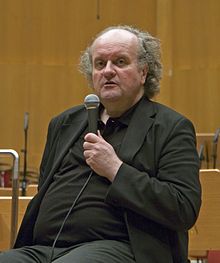This is an old revision of this page, as edited by Gerda Arendt (talk | contribs) at 11:39, 14 March 2016 (simpler). The present address (URL) is a permanent link to this revision, which may differ significantly from the current revision.
Revision as of 11:39, 14 March 2016 by Gerda Arendt (talk | contribs) (simpler)(diff) ← Previous revision | Latest revision (diff) | Newer revision → (diff)| Die Hamletmaschine | |
|---|---|
| Opera by Wolfgang Rihm | |
 Wolfgang Rihm, in 2007 Wolfgang Rihm, in 2007 | |
| Description | Error: {{Lang}}: text has italic markup (help) |
| Librettist | Wolfgang Rihm |
| Language | German |
| Based on | Heiner Müller's play Die Hamletmaschine |
| Premiere | 30 March 1987 (1987-03-30) Nationaltheater Mannheim |
Die Hamletmaschine is an opera composed by Wolfgang Rihm to a German-language libretto based on Heiner Müller's 1977 play of the same name. The libretto, subtitled Musiktheater in 5 Teilen (Music Drama in 5 parts), was written by the composer. The opera was composed between 1983 and 1986 and premiered on 30 March 1987 at the Nationaltheater Mannheim.
Background
Müller's play, on which the opera is based, paraphrases Shakespeare's Hamlet. In the play's first staged production, directed by Robert Wilson, the first words—"Ich war Hamlet." (I was Hamlet.)—were spoken after 20 minutes of silent action. Rihm composed his opera between 1983 and 1986 and presented parts of the score for the Rolf-Liebermann-Preis of Hamburg, which he won in 1986.
Performance history
Die Hamletmaschine premiered on 30 March 1987 at the Nationaltheater Mannheim in a production directed by Friedrich Meyer-Oertel and conducted by Peter Schneider. The role of Ophelia, written for a Wagnerian soprano, was sung by Gabriele Schnaut. The Hamlet character was portrayed at different stages in his life by three separate performers: the actors Kurt Müller and Rudolf Kowalski as Hamlet I and Hamlet II, and the baritone Johannes M. Kösters as Hamlet III.
A live recording of the opera's premiere was released on CD in 1995 (Wergo #6195)
Roles
- Hamlet I (male actor)
- Hamlet II (male actor)
- Hamlet III (baritone)
- Ophelia (soprano)
- Ophelia's doubles: Marx (soprano), Lenin (soprano), Mao (mezzo-soprano)
- 3 naked women, voices from the casket (soprano, soprano, mezzo-soprano)
- 4 laughing people (2 female and 2 male actors)
- 3 screaming people (3 male actors)
Structure
- I. Familienalbum (Family Album)
- II. Das Europa der Frau (Europe of the Woman)
- III. Scherzo
- IV. Pest in Buda, Schlacht um Grönland (Pest in Buda, Battle of Greenland)
- V. Wildharrend, In der furchtbaren Rüstung, Jahrtausende (Wildstraining, In the Fearsome Armaments, Millennia)
Music
The opera is scored for actors, singing and speaking voices, choir and orchestra. The work is described in the Concise Oxford Dictionary of Opera as following Stockhausen in that it seeks "a total theatre of sound and nonnarrative, ritualistic drama." Sounds use the complete space of a hall by placing instrumentalists not only in the pit, but also on stage and in the audience. Sounds are mixed from live performance, electronic amplification and purely electronic sounds, described as soundscapes.
Other musical settings
Müller's play, which formed the basis for the libretto, has subsequently had two more musical settings—a chamber work by Ruth Zechlin for narrator and small orchestra (1991) and an oratorio for choir, soloists and orchestra by Georges Aperghis (2000).
References
- ^ Universal Edition. Wolfgang Rihm, Die Hamletmaschine: Musiktheater in 5 Teilen. Retrieved 21 July 2013.
- Herbort, Heinz Josef Herbort (29 May 1987). Letzte Szenen in Momentform / Verwirrung und Tod, Zwiespalt und Entscheidungslosigkeit gebannt in Bildern aus dem Geist der Musik, Die Zeit Template:De icon
- Wolfgang Rihm Biografie, Karlsruher Rihm Center Template:De icon. Retrieved 23 July 2013.
- ^ WERGO. Wolfgang Rihm, v. Retrieved 21 July 2013.
- AllMusic. Rihm: Die Hamletmaschine. Retrieved 21 July 2013.
- ^ Gelli, Piero and Poletti, Filippo (eds.) (2007). "Hamletmaschine", Dizionario dell'opera, p. 611. Dalai. Template:It icon
- Die Hamletmaschine (Musiktheater in 5 Teilen) operone Template:De icon
- Warrack, John and West, Ewan (eds.) (1996). "Rihm, Wolfgang", Concise Oxford Dictionary of Opera, p. 432. Oxford University Press.
- Elzenheimer, Regine (2008). Pause. Schweigen. Stille: Dramaturgien der Abwesenheit im postdramatischen Musik-Theater, Königshausen & Neumann, ps. 192–199 Template:De icon.
- Yunker, Johanna Frances (2013). "Father or Criminal: Ruth Zechlin's Post-Reunification Opera Die Reise", p. 3. AMS-SW Conference, Spring 2013, Our Lady of the Lake University, San Antonio. Retrieved 21 July 2013.
Further reading
- Neff, Severine (1990). "Die Hamletmaschine: Musiktheater in fünf Teilen (1983–1986) by Wolfgang Rihm". Notes, Second Series, Vol. 47, No. 1 (September 1990), pp. 215–217 (subscription required)